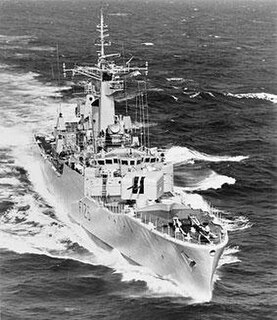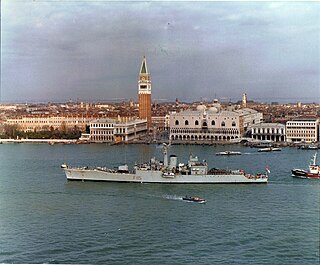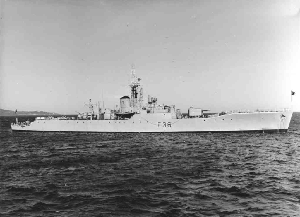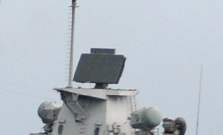
HMS Amazon was the first Type 21 frigate of the Royal Navy. Her keel was laid down at the Vosper Thornycroft shipyard in Southampton, England. The ship suffered a fire in the Far East in 1977, drawing attention to the risk of building warships with aluminium superstructure.

HMS Plymouth was a Royal Navy Rothesay-class frigate. In 1982, Plymouth was one of the first Royal Navy ships to arrive in the South Atlantic during the Falklands War.
The Malta-class aircraft carrier was a British large aircraft carrier design of World War II. Four ships were ordered in 1943 for the Royal Navy, but changing tactical concepts, based on American experience in the Pacific War, caused repeated changes to the design, which was not completed before the end of the war. All four ships were cancelled in 1945 before they were laid down.

HMS Torquay was a Type 12 Whitby-class frigate of the British Royal Navy. They were the first frigates to have the "V" form hull. This evolutionary design made it possible to be driven in head sea without the usual slamming which occurs with conventional destroyers of the time. Each frigate cost 3.5 million pounds and the first ship completed was Torquay in May 1956.

HMS Rothesay was the lead ship of the Rothesay or Type 12M class of anti-submarine frigates of the British Royal Navy. She was commissioned in 1960 and scrapped in 1988.

HMS Londonderry was a Rothesay or Type 12 class anti-submarine frigate of the British Royal Navy in service from 1960 to 1984.

HMS Brighton was a Rothesay or Type 12I class anti-submarine frigate of the Royal Navy.

HMS Lowestoft was a Rothesay or Type 12 class anti-submarine frigate of the British Royal Navy. Lowestoft was reconstructed in the late 1960s to largely the same pattern as the third group of Leander frigates, with new radar and fire control and a hangar and pad for a Wasp helicopter for longer range, anti submarine, engagement. In the late 1970s it was converted as the prototype towed array frigate for the Royal Navy, but retained its full armament. Lowestoft was sunk as a target on 8 June 1986 by HMS Conqueror using a Tigerfish torpedo. She was the last Royal Naval target to be sunk still displaying her pennant number.

HMS Berwick was a Rothesay- or Type 12I-class anti-submarine frigate of the British Royal Navy. She was built by Harland & Wolff and launched on 15 December 1959.

HMS Eastbourne was a Whitby-class or Type 12 anti-submarine frigate of the Royal Navy of the United Kingdom.

HMS Tenby was a Whitby-class or Type 12 anti-submarine frigate of the Royal Navy of the United Kingdom.

HMS Whitby was a Whitby-class or Type 12 anti-submarine frigate of the Royal Navy of the United Kingdom built by Cammell Laird and Co Ltd, Birkenhead. She was launched on 2 July 1954 and commissioned on 10 July 1956.
HMS Leopard (F14), was a Leopard-class Type 41 anti aircraft frigate of the British Royal Navy, named after the leopard.
The Type 79 radar was a British naval early-warning radar developed before World War II. It was the first radar system deployed by the Royal Navy.

The Type 281 radar was a British naval early warning radar developed during World War II. It replaced the Type 79 as the Royal Navy's main early warning radar during the war.
The Type 279 radar was a British naval early-warning radar developed during World War II from the Type 79 metric early-warning set. It initially had separate transmitting and receiving antennas that were later combined in the Type 279M to single-antenna operation. This set also had a secondary surface-search mode with surface and aerial gunnery capability and used a Precision Ranging Panel, which passed accurate radar ranges directly to the HACS table.

The EL/M-2238 3D-STAR is a multi-purpose air and surface-search naval radar system developed by IAI Elta for medium-sized ships like corvettes and frigates. STAR is an acronym of Surveillance & Threat Alert Radar.

The Type 291 radar was designed as a search radar for ships destroyer-sized and smaller in 1942. By the end of the Second World War it had been installed in almost every British and Commonwealth destroyer and escort ship as well as many submarines, naval trawlers, and motor torpedo boats. Some sets were furnished to the Soviet Union for their destroyers as a part of Lend-Lease.
This page is based on this
Wikipedia article Text is available under the
CC BY-SA 4.0 license; additional terms may apply.
Images, videos and audio are available under their respective licenses.
















